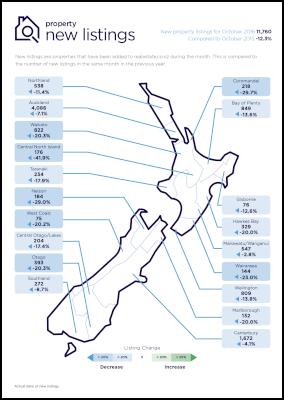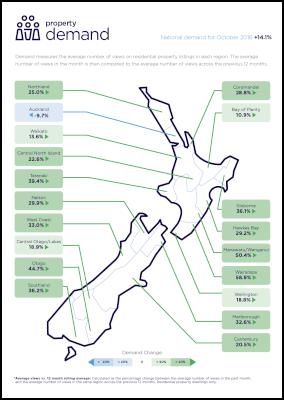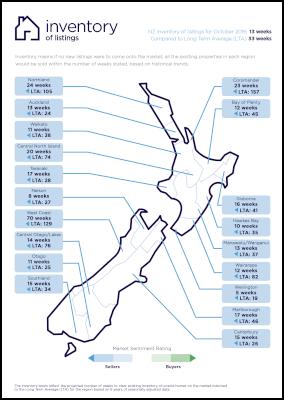Manawatu-Wanganui hits the property sweet spot
1 NOVEMBER 2016
Manawatu-Wanganui
hits the property sweet spot
while demand in the Auckland property market has
slowed
The Manawatu-Wanganui region has hit the property sweet spot not only with locals, but with Aucklanders and Wellingtonians who are increasingly searching for property on realestate.co.nz. The search is most popular among those in the 25 – 44 year old age group.
Real time statistics from realestate.co.nz for the month ending October, show that demand (as measured by taking the number of listing views of residential properties on the site and comparing it with the average number of views over the previous 12 months*) is up 50.4 per cent in Manawatu-Wanganui. Over the same period, demand for property in Auckland has fallen by 9.6 per cent.
“Kiwis across the country aspire to own their own home and while most of the people searching in Manawatu-Wanganui are from the local area, 33.4 per cent more Aucklanders are also looking in the region (when compared with the same time last year) for the perfect match for their budget,” says realestate.co.nz CEO Brendon Skipper.
Wellingtonians are also keen on the Manawatu-Wanganui region, with a 53 per cent increase in site users viewing properties in this region when compared with the same month last year (October 2015).
Most of the attention in the region is on Palmerston North. The city has a long-term reputation as being one of the most affordable centres in New Zealand.
The average asking price for a home in Manawatu-Wanganui is $288,267, compared with Auckland which in the same month rose to another all-time high of $943,258.
Of the 19 regions across the country, there are only two regions (West Coast and Southland) where the average asking price is lower than Manawatu-Wanganui.
“It makes sense that Aucklanders would be looking at other regions and not only exploring investment options, but also weighing up the lifestyle benefits of a move outside of the big city,” says Brendon.
In addition to popular West Coast beaches, Manawatu-Wanganui is well located for visiting other regions. Wellington, Wairarapa, Wanganui, Taupo, Hawke’s Bay and the Ohakune ski fields are all within a three-hour drive.
In the October realestate.co.nz rental yield statistics, Manawatu-Wanganui is ranked the third best place to invest in a rental property. Investors would theoretically receive 5.3 per cent yield over a 12-month period - based on realestate.co.nz’s calculation of average asking price vs weekly rental price, excluding all external costs. Another solid reason to look at investing in Manawatu-Wanganui.
Auckland, the shine has dulled
Auckland was the only region across the country where the total number of residential dwellings for sale (inventory) was up, compared to October 2015. Total stock fell in all other regions across New Zealand. While Auckland was up slightly (1.4 per cent), nationally the total housing stock levels fell dramatically (by 24 per cent) when compared to the same month last year.
“Auckland asking prices continue to rise and as such, homes are spending longer on the market. Vendors continue to be focused on selling at a premium while buyers are being more considered and taking time to assess all of their options. With more stock on the market buyers aren’t feeling the same pressure they were 12 months ago,” says Brendon.
If no new listings were to come onto market in Auckland, all the existing properties would be sold in 12.5 weeks, compared to 9.3 weeks in May this year.
It’s not just global travellers who think Taranaki is a hot spot
“Big kudos to Taranaki for being named by the renowned ‘Lonely Planet Best in Travel Awards’ as the second-best region in the world people should visit next year,” says Brendon Skipper.
“But it’s not just global travellers who have turned their attention to Taranaki,” he says.
New demand statistics generated by realestate.co.nz show that Aucklanders outnumber locals in terms of searching the region’s property offerings.
“It’s a hot destination and the market reflects its growing status,” says Brendon.
Taranaki property prices are now at an all-time high at $384,401, which is up 5.2 per cent on the previous month (September 2016).
There’s also a shortage of listings, down 28.1 per cent compared to October 2015.
“It’s a classic supply and demand situation,” says Brendon.
ENDS
* This month, realestate.co.nz has launched its new Property Demand Map which measures the average number of views on residential property listings in each region, and compares it to the average number of views over the previous 12 month period.
Regional breakdown of: average asking price when compared to the previous month (September 2016); new listings when compared with the same month in the previous year (October 2015); and demand which is taking the number of listing views of residential properties in the month (October 2016) and comparing it with the average number of views over the previous 12 months (August 2016 – September 2016):
Regional overview for the month of October 2016
| Region name | Average asking price | New listings | Demand |
| Auckland | $943,258 | -7.1% | -9.7% |
| Bay of Plenty | $550,290 | -13.6% | 10.9% |
| Canterbury | $482,986 | -4.1% | 20.5% |
| Central North Island | $392,554 | -41.9% | 22.6% |
| Central Otago/Lakes District | $831,600 | -17.4% | 18.9% |
| Coromandel | $591,310 | -29.7% | 28.8% |
| Gisborne | $291,391 | -12.6% | 36.1% |
| Hawkes Bay | $381,209 | -20.0% | 29.2% |
| Manawatu/Wanganui | $288,267 | -2.8% | 50.4% |
| Marlborough | $441,541 | -20.0% | 32.6% |
| Nelson & Bays | $503,978 | -29.0% | 29.9% |
| Northland | $528,908 | -11.4% | 25.0% |
| Otago | $333,993 | -20.3% | 44.7% |
| Southland | $264,397 | -8.7% | 36.2% |
| Taranaki | $384,401 | -17.9% | 39.4% |
| Waikato | $497,543 | 20.3% | 13.6% |
| Wairarapa | $349,992 | 23.0% | 58.9% |
| Wellington | $521,041 | 13.8% | 18.8% |
| West coast | $242,456 | 20.2% | 33.0% |
| National | $610,037 | -12.3% | 14.1% |
About realestate.co.nz
Dedicated only to property, realestate.co.nz is the official website of the New Zealand real estate industry. As a property listing site, the information it draws on for its property report is in real time. With the country’s most comprehensive selection of real estate listings, realestate.co.nz represents more than 97 per cent of all residential, commercial and rural properties currently marketed by real estate professionals.
Glossary of terms
Being the only provider of real estate data in real time, realestate.co.nz offers valuable property market information not available from other sources.
• Average asking price gives an indication of current market sentiment. Statistically, asking prices tend to correlate closely with the sales prices recorded in future months when those properties are sold. As it looks at different data, average asking prices may differ from recorded sales data released at the same time.
• Inventory is a measure of how long it would take, theoretically, to sell the current stock at current average rates of sale if no new properties were to be listed for sale. It provides a measure of the rate of turnover in the market.
• New listings are a record of all the new listings on realestate.co.nz for the relevant calendar month. As realestate.co.nz reflects 97 per cent of all properties listed through registered
estate agents in New Zealand, this gives a representative view of the New Zealand property market.
• Seasonal adjustment is a method realestate.co.nz uses to better represent the core underlying trend of the property market in New Zealand. This is done using methodology from the New Zealand Institute of Economic Research.
• Truncated mean is the method realestate.co.nz uses to provide statistically relevant asking prices.
The top and bottom 10 per cent of listings in each area are removed before the average is calculated, to prevent exceptional listings from providing false impressions.
• Demand measures the average number of views on residential property listings in each region, and compares it to the average number of views in that region over the previous 12 month period. Residential property dwellings only.

Click for big version.

Click for big version.

Click for big version.

Click for big version.


 University of Auckland Business School: Economists Urge Action To Prevent ‘AI Poverty Traps’
University of Auckland Business School: Economists Urge Action To Prevent ‘AI Poverty Traps’ Bill Bennett: Australian warship takes rural fixed wireless broadband offline
Bill Bennett: Australian warship takes rural fixed wireless broadband offline NZ Telecommunications Forum - TCF: New Zealand Is Saying Goodbye To 3G: Are You Ready For The Change?
NZ Telecommunications Forum - TCF: New Zealand Is Saying Goodbye To 3G: Are You Ready For The Change? NZ Post: Mānawatia A Matariki - NZ Post Stamps Look To The Stars Ahead Of The Māori New Year
NZ Post: Mānawatia A Matariki - NZ Post Stamps Look To The Stars Ahead Of The Māori New Year Waipa Networks: Cambridge Is Open For Business With $45M Energy Boost
Waipa Networks: Cambridge Is Open For Business With $45M Energy Boost Master Plumbers Gasfitters and Drainlayers NZ: New Consumer NZ Test Reveals Danger Of Unregulated Online Plumbing Products
Master Plumbers Gasfitters and Drainlayers NZ: New Consumer NZ Test Reveals Danger Of Unregulated Online Plumbing Products


